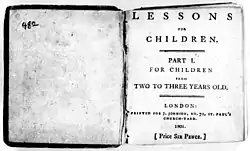安娜·拉埃蒂茨娅·巴鲍德
安娜·拉埃蒂茨娅·巴鲍德(Anna Laetitia Barbauld,/bɑːrˈboʊld/,婚前姓艾金Aikin;1743年6月20日—1825年3月9日[1])是一位英国诗人,散文家,文学评论家,编辑和儿童文学作家。

巴鲍德是一个出版过多种类型作品的“知识分子”,在女性很少是职业作家的时代,她的写作生涯很成功。她是帕尔格雷夫学院的著名教师,也是创新的儿童文学作家;她写的儿童启蒙书为一个多世纪的教育学提供了典范。[2]她的文章表明,女性有可能公开从事政治活动,而伊丽莎白·班格等其他女性作家则效仿她。[3]巴鲍德的文学生涯跨越了英国文学史上的许多时期:她的作品提升了啟蒙時代和感性的价值,而她的诗歌则为英国浪漫主义的发展做出了创造性的贡献。[4]巴鲍德也是一位文学评论家。她对18世纪小说的选集有助于建立今天所知的经典。
巴鲍德的诗人生涯在1812年突然结束,当时她出版了《Eighteen Hundred and Eleven》,批评了英国参加拿破崙戰爭。她对她收到的恶毒评论感到震惊,终生没有发表任何评论。[5]当在法国大革命的鼎盛时期受到她启发的许多浪漫主义诗人在后来更保守的年代转而反对她时,她的声誉进一步受到损害。巴鲍德在19世纪作为一个迂腐的儿童作家而被人们记住,并且在20世纪被遗忘,直到20世纪80年代女权主义文学批评的兴起才重新唤起了对她作品的兴趣并恢复了她在文学史上的地位。[6]
作品列表
| 關於安娜·拉埃蒂茨娅·巴鲍德 的圖書館資源 |
| 安娜·拉埃蒂茨娅·巴鲍德的作品 |
|---|
儿童文学
巴鲍德为孩子们写的《兒童啟蒙教程》和《儿童散文赞美诗》是儿童文学的革命。有史以来第一次认真考虑了儿童读者的需求。巴鲍德要求她的书籍页边距要宽,以便孩子们能够轻松阅读,更重要的是,她开发了一种“父母和孩子之间的非正式对话”的风格,这种风格将主导儿童文学一代人。[7]《兒童啟蒙教程》一本四卷,是低年龄儿童的阅读入门书,它采用母亲教育儿子的概念。更有可能的是,这些故事中的许多事件都是受到巴鲍德教导她自己的儿子查尔斯的经历的启发。这一系列不仅仅是介绍识字的方法,它还向儿童读者介绍了“社会符号系统和概念结构的要素,灌输了一种伦理,并鼓励他发展某种情感。”这一系列启蒙教程是比较流行的,玛利亚·埃奇沃思在教育论文中评论说它是“七岁到十岁的年轻人最好的书之一。”[8]
- 1768: Corsica: An Ode
- 1773: Poems (页面存档备份,存于), . 1777.
- 1773: Miscellaneous Pieces in Prose (with John Aikin)
- 1775: Devotional Pieces, Compiled from the Psalms and the Book of the Job
- 1778: Lessons for Children from Two to Three Years Old (London: J. Johnson)[9][10]
- 1778: Lessons for Children of Three Years Old (London: J. Johnson)
- 1779: Lessons for Children from Three to Four Years Old (London: J. Johnson)[9]
- 1781: Hymns in Prose for Children (London: J. Johnson)[9]
- 1787: Lessons for Children, Part Three (London: J. Johnson)[9]
- 1788: Lessons for Children, Part Four (London: J. Johnson)[9]
- 1790: An Address to the Opposers of the Repeal of the Corporation and Test Acts
- 1791: An Epistle to William Wilberforce, Esq. on the Rejection of the Bill for Abolishing the Slave Trade (页面存档备份,存于) (London: J. Johnson)[10]
- 1792: Civic Sermons to the People
- 1792: Poems. A new edition, corrected. To which is added, An Epistle to William Wilberforce (London: J. Johnson)[10]
- 1792: Remarks on Mr. Gilbert Wakefield's Enquiry into the Expediency and Propriety of Public or Social Worship (London: J. Johnson)[10]
- 1792–96: Evenings at Home, or The Juvenile Budget Opened (with John Aikin, six volumes)
- 1793: Sins of Government, Sins of the Nation (1793)
- 1794: Reasons for National Penitence Recommended for the Fast Appointed on 28 February 1794
- 1798: "What is Education?" (页面存档备份,存于) Monthly Magazine 5
- 1800: Odes, by George Dyer, M. Robinson, Anna Laetitia Barbauld, J. Ogilvie, &c. (Ludlow: G. Nicholson)[10]
- 1802: The Arts of Life (with John Aikin)
- 1804: The Correspondence of Samuel Richardson . . . to which are prefixed, a biographical account of that author, and observations on his writing, (London: Richard Phillips;[10] edited with substantial biographical introduction, 6 vols)
- 1805: Selections from the Spectator, Tatler, Guardian, and Freeholder, with a Preliminary Essay (London: J. Johnson;[10] edited with an introduction, three volumes)
- 1805: The Poetical Works of Mark Akenside (London: W. Suttaby; edited)[10]
- 1810: The British Novelists; with an Essay; and Prefaces, Biographical and Critical, by Mrs. Barbauld (页面存档备份,存于), (London: F. C. & J. Rivington;[10] edited with a comprehensive introductory essay and introductions to each author, 50 volumes)
- 1810: An Essay on the Origin and Progress of Novel-Writing
- 1811: The Female Speaker; or, Miscellaneous Pieces in Prose and Verse, Selected from the Best Writers, and Adapted to the Use of Young Women (London: J. Johnson;[10] edited)
- 1812: Eighteen Hundred and Eleven (London: J. Johnson)[10]
- 1825: The Works of Anna Laetitia Barbauld. With a Memoir by Lucy Aikin, Volume 1 (London: Longman; edited by Barbauld's niece, Lucy Aikin)[10]
- 1826: A Legacy for Young Ladies, Consisting of Miscellaneous Pieces, in Prose and Verse (London: Longman;[10] edited by Barbauld's niece, Lucy Aikin, after Barbauld's death)
注释
- . 線上版. 牛津大學出版社. doi:10.1093/ref:odnb/1324
 .
. - William McCarthy, "Mother of All Discourses: Anna Barbauld's Lessons for Children"; Culturing the Child, 1690–1914: Essays in Memory of Mitzi Myers, ed. Donelle Ruwe. Lanham, MD: The Children's Literature Association and the Scarecrow Press, Inc. (2005).
- Armstrong, Isobel. "The Gush of the Feminine: How Can we Read Women's Poetry of the Romantic Period?" Romantic Women Writers: Voices and Countervoices, eds Paula R. Feldman and Theresa M. Kelley. Hanover: University Press of New England (1995); Anne K. Mellor. "A Criticism of Their Own: Romantic Women Literary Critics." Questioning Romanticism, ed. John Beer. Baltimore: Johns Hopkins Univ. Press (1995).
- Anne Janowitz, Women Romantic Poets: Anna Barbauld and Mary Robinson. Tavistock: Northcote House (2003).
- Anna Letitia Barbauld, Anna Letitia Barbauld: Selected Poetry and Prose, eds. William McCarthy and Elizabeth Kraft. Peterborough: Broadview Press Ltd. (2002), p. 160.
- William McCarthy, "A 'High-Minded Christian Lady': The Posthumous Reception of Anna Letitia Barbauld." Romanticism and Women Poets: Opening the Doors of Reception, eds. Harriet Kramer Linkin and Stephen C. Behrendt. Lexington: University Press of Kentucky, (1999).
- McCarthy, "Mother of All Discourses," pp. 88–89.
- Edgeworth, Maria. Practical Education, The Novels and Selected Works of Maria Edgeworth, ed. Susan Manly, Vol. 11. London: Pickering and Chatto (2003), p. 195.
- For dating on these volumes, also see Myers.
- White, Daniel E., Web page titled "Selected Bibliography: Anna Letitia Barbauld (1743–1825)" (页面存档备份,存于), at Rutgers University Web site, retrieved 8 January 2009
外部链接
| 维基文库中的相关原始文献:Anna Laetitia Barbauld |
| 维基共享资源上的相关多媒体资源:安娜·拉埃蒂茨娅·巴鲍德 |
- 安娜·拉埃蒂茨娅·巴鲍德 (页面存档备份,存于) 在 十八世纪诗歌档案(ECPA) (页面存档备份,存于)
- 安娜·拉埃蒂茨娅·巴鲍德的作品 - 古騰堡計劃
- 互联网档案馆中安娜·拉埃蒂茨娅·巴鲍德的作品或与之相关的作品
 來自安娜·拉埃蒂茨娅·巴鲍德的LibriVox公共領域有聲讀物
來自安娜·拉埃蒂茨娅·巴鲍德的LibriVox公共領域有聲讀物- 安娜·拉埃蒂茨娅·巴鲍德 (页面存档备份,存于) 在 女作家庆典 (页面存档备份,存于)
- 安娜·拉埃蒂茨娅·巴鲍德的散文作品
- 《安娜·拉埃蒂茨娅·巴鲍德作品的全彩色传真》(1825年) (页面存档备份,存于)
- 浪漫主义文学圈中的安娜·拉埃蒂茨娅·巴鲍德 (页面存档备份,存于)
